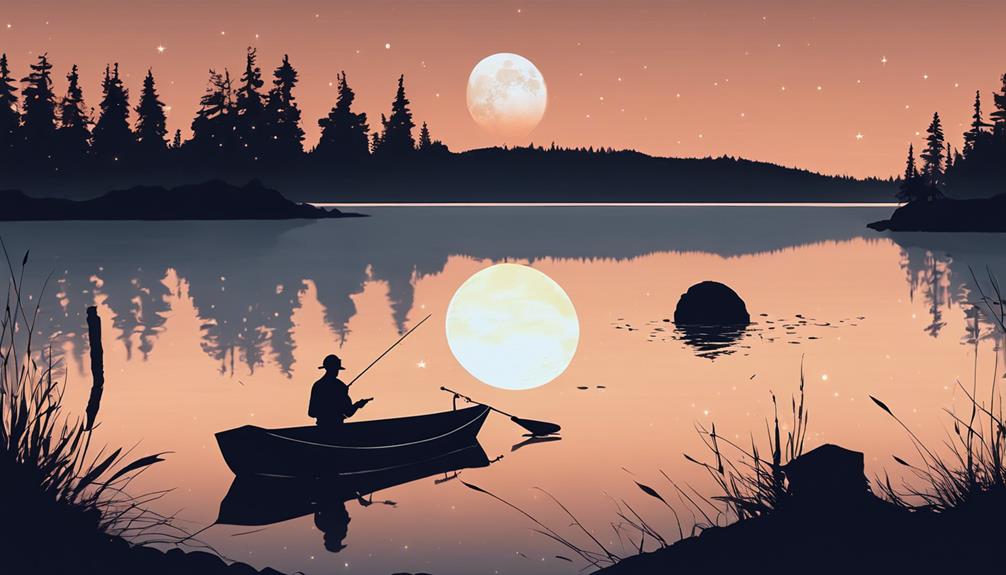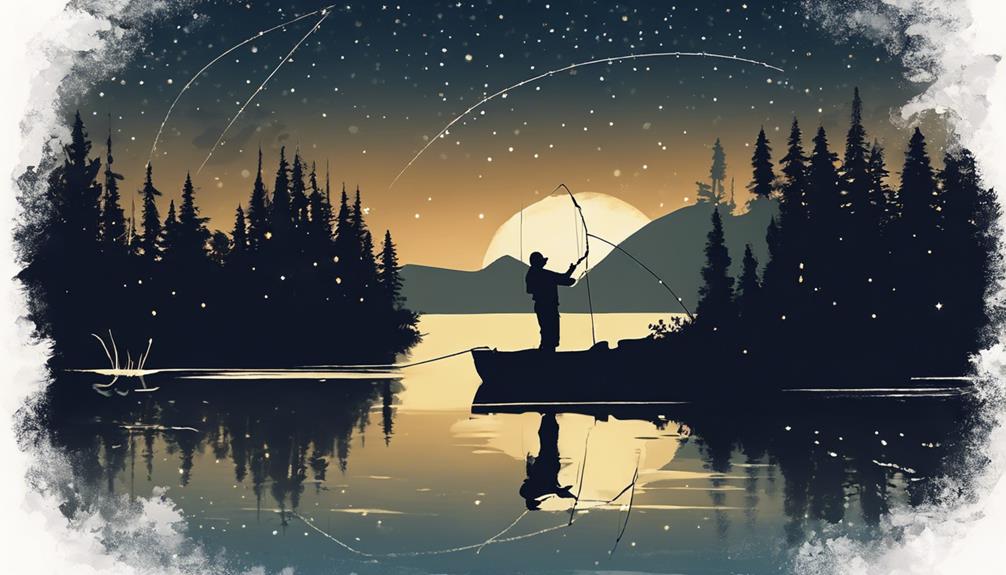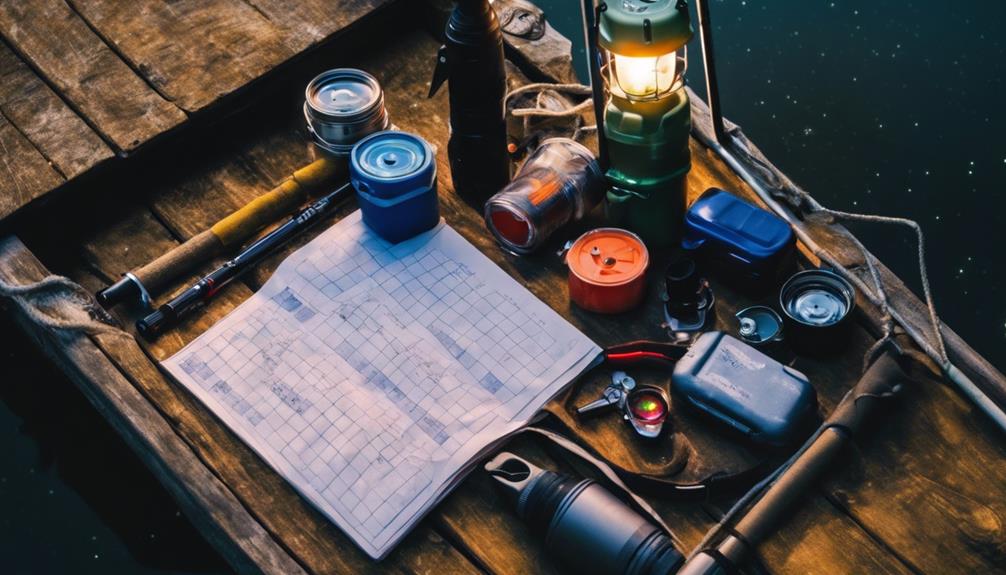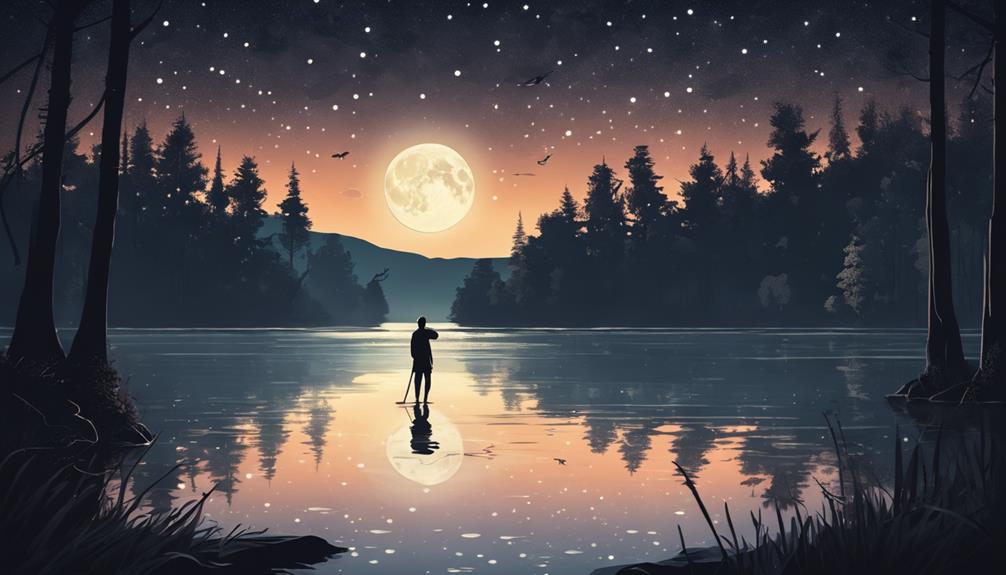To excel at night crappie fishing, pay attention to moon phases, with full moons boosting activity. Opt for light rods, spinning reels, and 4-8 lb lines. Employ live minnows or artificial jigs as bait. Locate crappie near underwater structures using lights. Experiment with different baits and lures. Consider weather conditions and employ slow retrieval techniques. Use lighted bobbers for visibility. Cleanup tip: scale fish, remove entrails, rinse thoroughly, and store on ice. Mastering these tips will enhance your night crappie fishing adventures with greater success.
Best Time to Fish
To maximize your chances of catching crappie during the night, it's crucial to understand the best times to fish. When considering moon phases, fishing success can be influenced by the lunar cycle. During the full moon, crappie tend to feed more actively, as the increased light can attract prey and make it easier for them to hunt. Conversely, during the new moon, when the night is darker, crappie may be less active, making it more challenging to catch them. Therefore, targeting your night fishing trips around the full moon can enhance your chances of success.
Weather conditions also play a significant role in night fishing for crappie. Crappie are sensitive to changes in weather patterns, particularly in relation to barometric pressure. A stable barometric pressure often leads to more consistent feeding behavior in crappie. Fishing just before a front moves in can be especially productive, as the changing pressure can trigger increased feeding activity. Additionally, cloudy nights can be advantageous, as they provide cover for crappie to move into shallower waters to feed without feeling exposed.
Ideal Equipment for Night Fishing
For optimal success in night crappie fishing, selecting the right equipment is crucial. When it comes to rod selection, opt for a light to medium-action rod. These rods provide the sensitivity needed to detect subtle bites while still offering the necessary strength to handle larger crappie. Pair your rod with a spinning reel for ease of use and better control when casting in low light conditions.
Choosing the correct line weight is essential for night fishing. A monofilament line in the 4-8 lb test range is ideal for crappie. This weight allows for better sensitivity to detect bites while still providing enough strength to reel in your catch. Additionally, consider using a fluorocarbon leader to increase invisibility in the water, especially under the cover of darkness.
When it comes to lure options, jigs are a popular choice among night crappie anglers. Opt for jigs in various colors such as chartreuse, pink, or white to see what the fish are responding to on a given night. Experiment with jig sizes and styles to find what works best in your fishing spot. Glow-in-the-dark jigs can also be effective in attracting crappie in low light conditions. Remember to adjust your retrieval speed to entice strikes from these nocturnal feeders.
Choosing the Right Bait
Selecting the appropriate bait plays a vital role in optimizing your success during night crappie fishing expeditions. When it comes to bait selection and lure options, making informed choices can significantly impact your catch rate. Here are five key points to consider:
- Live Minnows: Crappies are known to be attracted to live bait such as minnows. Using lively minnows can entice more bites from these fish during the night.
- Artificial Jigs: Jigs are versatile and can mimic the movement of small fish or insects. Opt for jigs with reflective surfaces to catch the moonlight and attract crappies.
- Soft Plastic Lures: Soft plastic lures can be effective in imitating the movements of prey. Choose lures in colors like chartreuse or white for better visibility in low-light conditions.
- Spinners and Crankbaits: These lures create vibrations and movements that can grab the attention of crappies in the dark. Experiment with different sizes and colors to see what works best.
- Glow-in-the-Dark Lures: Glow-in-the-dark lures are designed to be visible in the dark waters, making them an excellent choice for night fishing. Their luminescent properties can attract curious crappies even in low-light situations.
Locating Crappie at Night
When night fishing for crappie, identifying their preferred habitats can significantly enhance your chances of a successful catch. Crappie are known to be attracted to light, which makes using lights a useful technique for locating them at night. Lights can draw in baitfish, which in turn attract crappie looking for an easy meal. Setting up lights near structures like submerged trees, docks, or brush piles can increase the likelihood of finding crappie in these areas.
Crappie tend to move from deeper waters to shallower areas during the night to feed, making shallow flats, points, and drop-offs prime night fishing spots. These areas offer crappie the opportunity to ambush their prey while providing easy access to deeper water for safety. Look for transitions in the underwater terrain, such as changes in bottom composition or depth, as these are often productive spots for crappie feeding at night.
When exploring night fishing spots, pay attention to any signs of crappie activity, such as surface ripples or splashes. These can indicate feeding crappie nearby. By strategically using lights and focusing on the right night fishing spots, you can increase your chances of locating crappie and having a successful night fishing excursion.
Techniques for Night Crappie Fishing
To effectively catch crappie at night, employing proven fishing techniques tailored to low-light conditions is paramount. When it comes to night crappie fishing, understanding the influence of moon phases and weather conditions is crucial. Here are some techniques to help you enhance your night crappie fishing experience:
- Focus on Moon Phase: Pay attention to the moon phase as it can greatly impact crappie behavior. During a full moon, crappie tend to be more active and might feed throughout the night. On the other hand, during a new moon, they may be less active and harder to catch.
- Utilize Light: Use submersible fishing lights to attract plankton and baitfish, which in turn attract crappie. The light can help you see better and draw crappie closer to your location.
- Slow Retrieval: Crappie aren't as aggressive at night, so use slow retrieval techniques. Jig your bait gently and allow the crappie more time to strike.
- Experiment with Baits: Try different types of baits such as live minnows, jigs, or soft plastics to see what the crappie are responding to best on that particular night.
- Monitor Weather Conditions: Keep an eye on weather conditions as changes can affect crappie behavior. A sudden drop in temperature or an approaching storm might make crappie more active.
Safety Precautions to Consider
Consider the following safety precautions to ensure a secure night crappie fishing experience. When engaging in night fishing, it's crucial to be well-prepared for the unique challenges that come with reduced visibility and changing weather conditions.
Firstly, always check the weather forecast before heading out. Sudden changes in weather can pose serious risks, especially when you're out on the water at night. Be aware of any potential storms or high winds that could affect your safety.
Secondly, invest in high-quality lighting equipment. Proper lighting not only helps you see better but also makes you more visible to other boaters or anglers in the area. Attach a bright light to your boat or wear a headlamp to illuminate your surroundings. This will help prevent accidents and ensure you can navigate safely in the dark.
Additionally, wearing a life jacket is non-negotiable. Even the most experienced swimmers can encounter difficulties in rough waters or unexpected situations. A life jacket can be a lifesaver in emergencies, providing buoyancy and keeping you afloat until help arrives. Always have one on board for each person and ensure they're worn at all times.
Tips for Maximizing Success

For optimal success in night crappie fishing, employing strategic techniques and utilizing specialized gear can significantly enhance your catch rate. When aiming to maximize your success during night fishing adventures, paying attention to moon phases and weather conditions becomes crucial.
Here are some tips to help you make the most out of your night crappie fishing experience:
- Moon Phases: Understanding the moon phases can be beneficial. During the full moon, crappie tend to be more active, feeding closer to the surface. On the other hand, during the new moon, they might move to deeper waters. Adjust your fishing strategy accordingly based on the moon phase to increase your chances of a successful catch.
- Weather Conditions: Keep an eye on the weather forecast before heading out. Crappie are sensitive to changes in weather, especially atmospheric pressure. Fishing before a front arrives or after it passes can often lead to increased activity. Additionally, overcast skies or light rain can make crappie more active, presenting a better opportunity for successful fishing.
- Use Lighted Bobbers: Lighted bobbers can help you see when a crappie takes the bait, even in the dark. This visual aid can significantly improve your reaction time, leading to more successful hook sets.
- Fish Near Structure: Crappie are known to gather around underwater structures like brush piles, fallen trees, or rocks. Fishing near these structures increases your chances of encountering a school of crappie.
- Experiment with Baits: Crappie can be picky eaters, so don't hesitate to experiment with different baits and lures. Sometimes changing the color, size, or type of bait can make a significant difference in your catch rate.
Cleaning and Storing Your Catch
When cleaning and storing your catch of crappie, it's essential to handle the fish properly to maintain their quality and freshness for later consumption. To ensure that your crappie remains delicious, follow these cleaning tips. Begin by scaling the fish using a scaler or knife, scraping from the tail towards the head. Next, make a small incision behind the gills and remove the entrails. Rinse the crappie thoroughly under cold water to remove any remaining blood or debris. Pat the fish dry with paper towels before filleting or cooking.
Proper storage solutions are vital to preserving the taste and texture of your crappie. After cleaning, store the fish on ice or in a cooler to keep it fresh. If you plan to consume the crappie within a day or two, refrigeration at temperatures below 40°F is ideal. For longer storage, consider freezing the fish. Wrap individual fillets or whole fish tightly in plastic wrap and then aluminum foil to prevent freezer burn. Place them in airtight containers or freezer bags before storing in the freezer. Remember to label the packages with the date to keep track of freshness.
Frequently Asked Questions
How Do Weather Conditions Affect Night Crappie Fishing Success?
Weather conditions significantly impact night crappie fishing success. Temperature fluctuations can affect fish behavior, with crappies being more active in stable temperatures.
Moon phases also play a role, with full moons often leading to increased activity. Barometric pressure and wind patterns can influence fish movement and feeding times.
To improve your night crappie fishing success, consider these factors and plan your outings accordingly.
Can Artificial Lights Improve Visibility for Night Crappie Fishing?
When fishing for crappie at night, using artificial lights on your boat can significantly improve underwater visibility. These lights attract insects, which in turn draw baitfish, ultimately bringing crappie closer to your location.
The increased visibility provided by boat lights can help you identify structures and cover where crappie might be hiding. Consider combining this with strategic bait selection to capitalize on the behavior of crappie during nighttime feeding patterns.
Are There Specific Moon Phases That Are Best for Night Crappie Fishing?
When considering lunar cycles for night crappie fishing, specific moon phases can indeed impact your fishing success. Understanding how the moon affects crappie behavior at night is crucial.
Certain moon phases like the full moon can increase feeding activity, making it an optimal time for fishing. On the other hand, during new moon phases, crappie may be less active and harder to catch.
Being aware of these lunar influences can significantly enhance your night fishing experience.
What Are Common Mistakes to Avoid During Night Crappie Fishing?
When night crappie fishing, it's crucial to avoid common mistakes to increase your chances of success. Proper bait selection and effective line management are key elements to focus on.
Choosing the right bait can attract more crappie, while managing your line properly can prevent tangles and ensure smooth retrieval. By avoiding mistakes in these areas, you can optimize your night fishing experience and improve your chances of catching more crappie.
How Can One Prevent Insect Bites While Night Fishing for Crappie?
To prevent insect bites while night fishing for crappie, you should use bug repellent on exposed skin and wear protective clothing like long sleeves and pants.
Additionally, utilize light sources strategically to deter bugs, such as lanterns placed away from your fishing spot.
Conclusion
In conclusion, night crappie fishing can be a rewarding experience if done correctly. By fishing during the best time, using the right equipment and bait, locating crappie effectively, employing proper techniques, and considering safety precautions, you can maximize your success.
Remember to clean and store your catch properly to ensure the freshness of your catch. With these tips in mind, you can enhance your night crappie fishing experience and increase your chances of a successful trip.



